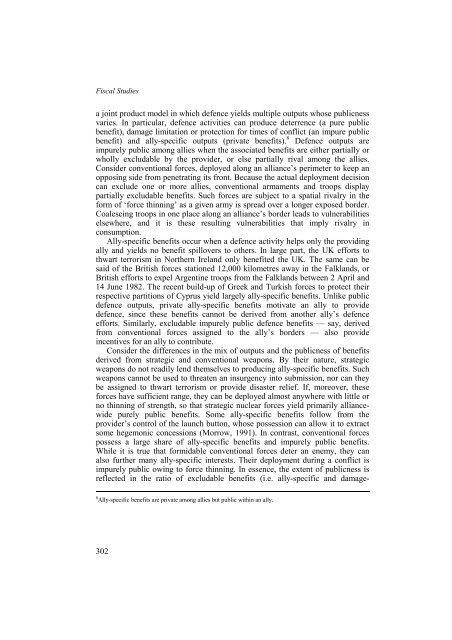On sharing NATO defence burdens in the 1990s and beyond
On sharing NATO defence burdens in the 1990s and beyond
On sharing NATO defence burdens in the 1990s and beyond
Create successful ePaper yourself
Turn your PDF publications into a flip-book with our unique Google optimized e-Paper software.
Fiscal Studiesa jo<strong>in</strong>t product model <strong>in</strong> which <strong>defence</strong> yields multiple outputs whose publicnessvaries. In particular, <strong>defence</strong> activities can produce deterrence (a pure publicbenefit), damage limitation or protection for times of conflict (an impure publicbenefit) <strong>and</strong> ally-specific outputs (private benefits). 8 Defence outputs areimpurely public among allies when <strong>the</strong> associated benefits are ei<strong>the</strong>r partially orwholly excludable by <strong>the</strong> provider, or else partially rival among <strong>the</strong> allies.Consider conventional forces, deployed along an alliance’s perimeter to keep anoppos<strong>in</strong>g side from penetrat<strong>in</strong>g its front. Because <strong>the</strong> actual deployment decisioncan exclude one or more allies, conventional armaments <strong>and</strong> troops displaypartially excludable benefits. Such forces are subject to a spatial rivalry <strong>in</strong> <strong>the</strong>form of ‘force th<strong>in</strong>n<strong>in</strong>g’ as a given army is spread over a longer exposed border.Coalesc<strong>in</strong>g troops <strong>in</strong> one place along an alliance’s border leads to vulnerabilitieselsewhere, <strong>and</strong> it is <strong>the</strong>se result<strong>in</strong>g vulnerabilities that imply rivalry <strong>in</strong>consumption.Ally-specific benefits occur when a <strong>defence</strong> activity helps only <strong>the</strong> provid<strong>in</strong>gally <strong>and</strong> yields no benefit spillovers to o<strong>the</strong>rs. In large part, <strong>the</strong> UK efforts tothwart terrorism <strong>in</strong> Nor<strong>the</strong>rn Irel<strong>and</strong> only benefited <strong>the</strong> UK. The same can besaid of <strong>the</strong> British forces stationed 12,000 kilometres away <strong>in</strong> <strong>the</strong> Falkl<strong>and</strong>s, orBritish efforts to expel Argent<strong>in</strong>e troops from <strong>the</strong> Falkl<strong>and</strong>s between 2 April <strong>and</strong>14 June 1982. The recent build-up of Greek <strong>and</strong> Turkish forces to protect <strong>the</strong>irrespective partitions of Cyprus yield largely ally-specific benefits. Unlike public<strong>defence</strong> outputs, private ally-specific benefits motivate an ally to provide<strong>defence</strong>, s<strong>in</strong>ce <strong>the</strong>se benefits cannot be derived from ano<strong>the</strong>r ally’s <strong>defence</strong>efforts. Similarly, excludable impurely public <strong>defence</strong> benefits — say, derivedfrom conventional forces assigned to <strong>the</strong> ally’s borders — also provide<strong>in</strong>centives for an ally to contribute.Consider <strong>the</strong> differences <strong>in</strong> <strong>the</strong> mix of outputs <strong>and</strong> <strong>the</strong> publicness of benefitsderived from strategic <strong>and</strong> conventional weapons. By <strong>the</strong>ir nature, strategicweapons do not readily lend <strong>the</strong>mselves to produc<strong>in</strong>g ally-specific benefits. Suchweapons cannot be used to threaten an <strong>in</strong>surgency <strong>in</strong>to submission, nor can <strong>the</strong>ybe assigned to thwart terrorism or provide disaster relief. If, moreover, <strong>the</strong>seforces have sufficient range, <strong>the</strong>y can be deployed almost anywhere with little orno th<strong>in</strong>n<strong>in</strong>g of strength, so that strategic nuclear forces yield primarily alliancewidepurely public benefits. Some ally-specific benefits follow from <strong>the</strong>provider’s control of <strong>the</strong> launch button, whose possession can allow it to extractsome hegemonic concessions (Morrow, 1991). In contrast, conventional forcespossess a large share of ally-specific benefits <strong>and</strong> impurely public benefits.While it is true that formidable conventional forces deter an enemy, <strong>the</strong>y canalso fur<strong>the</strong>r many ally-specific <strong>in</strong>terests. Their deployment dur<strong>in</strong>g a conflict isimpurely public ow<strong>in</strong>g to force th<strong>in</strong>n<strong>in</strong>g. In essence, <strong>the</strong> extent of publicness isreflected <strong>in</strong> <strong>the</strong> ratio of excludable benefits (i.e. ally-specific <strong>and</strong> damage-8 Ally-specific benefits are private among allies but public with<strong>in</strong> an ally.302
















